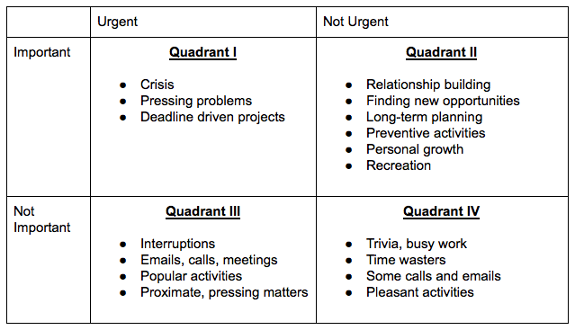There are many tools to plan your day and tasks nowadays. But which methods and techniques are the most effective? Honestly, I think it all depends on a person: different things work for different people. However, below I’ll share some techniques I know or use myself and find them efficient.
- The simplest
This one is a piece of cake and I use it on a daily basis. I write the things I need to do during the week. Then, I arrange them by days. And finally, I prioritize the tasks according to their urgency and importance within one day. I do it in a draft in my inbox or, more frequently, in Google calendar as I can set notifications and reminders for myself and I can arrange tasks by time. The advantage of this tool is that it’s simple and quick to do. Although, it can be difficult to follow the tasks as it’s not quite user-friendly and graphic.

- Sticky notes
This one is so widespread among teachers and I would say even people of other professions. However, I must say that I do not quite like it. The pluses are: you see what you need to do, it “sticks out” and it’s noticeable. However, it’s usually a bunch of tasks stuck in random order. You cannot focus or determine the order of the things you need to do. I know some teachers use sticky notes of different colours, e.g. red for urgent tasks, yellow for less urgent, green for not important, etc. But for me, it’s still just a chaos of tasks 🙂

Trello is a tool to organize your projects or tasks into boards.
For example, you can have boards:
- “To-do”, “Doing”, “Done”.
- By days: Monday, Tuesday, etc. and have cards with tasks.
- By students, e.g., Misha — send extra exercises. Anna — check HW, etc.
- By work, e.g. school — prepare materials for the lesson; private students — find past papers for FCE; language courses — complete the timesheet, etc.
The pros are it’s easy to use and organize your tasks; it’s quite user-friendly; you can attach files, set deadlines and checklists. The cons are: you need the Internet connection to use it; it’s a website you need to open, not something that is always at hand.
- Stephen Covey matrix
If you are interested in time-management, planning and being efficient, you are probably acquainted with Stephen Covey and his famous books: “The 7 Habits of Highly Effective People”, “First things first”, “The 8th habit”, etc. He is also known for his Time Management Matrix.

This is where using sticky notes can be practical. You make a big matrix, it’s better to make it of a carton or draw on a board, so you can use it permanently. Then, you write things you need to do today on sticky notes. And finally, you stick them on the appropriate quadrant or square. You can do it without sticky notes as well, just write on the board.
- Different apps
There are lots of apps that can help you to organize your day and not to feel overwhelmed with tasks. Todoist is one that is easy to use. You can track all the tasks, set the due dates, review the days and weeks ahead, highlight the most essential things and many other things.
My general tips are:
- plan your day in advance, spend 15 minutes every day on your next day planning;
- prioritise tasks;
- be realistic, do not plan too many things not to be up to your ears with tasks;
- stay focused, do not get distracted by trifles and inessential things;
- set deadlines or you will keep putting off your duties;
- motivate and reward yourself, if you’ve finished a task or a part of it, make yourself a cup of coffee or go for a 15-minutes walk.






 Вероника Аветисян
Вероника Аветисян 
 Маргарита Аветисян
Маргарита Аветисян 


